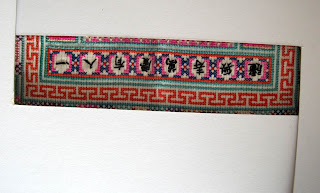I have two of my bags to show you and they really are stunning pieces.
This one is fascinating, very beautiful and very heavy - its weights 1lb 4oz .Covered in glass beads on linen on the outside , leather and linen on the inside. This bag depicts many symbols which at first were a bit of a mystery- but with some reseach I think I have discovered where its from.
Showing the Union flag of British Isles and the double headed eagle, it also has eight pointed stars, geese and reindeer in the design.
Because of the nature of beadwork motifs tend to be geometric and angular, so everything appears very stylised.
The double headed eagle appears in many cultures , Asia, Russia and various other countries. However I believe this one is Gandeberunda from Hindu mythology. Mostly used in Mysore, South West India, it is depicted in many Hindu temples and is a design element used throughout the area.
The Union flag appeared on the Indian flag in the early years of the 20th century and was an element used in much of the design work before the Independence of Indian.
The eight pointed star again appears in many cultures and generally means peace. Flowers and leaves are also worked into the design.
A stunning piece of beadwork I think you will agree!
The back of the bag was what initially confused me as it has reindeers and geese on. Reindeers in Indian did not seem to fit ?
Upon research I have found that the reindeer (deer or stag) is the symbol for the Hindu goddess of knowledge, music and the arts. Know as Saraswati in Sanskrit her sign is used in many decorative items. The goose or aquatic bird is called Hamsa in Sanskrit and again is often used as a decorative element.
The inside of the envelope bag is lined with an embossed blue and white leather with a linen lining on the flap.
Beading Edging at corners.
It has a clutch metal frame with pocket ( with original mirror).
Note the tassel fringing and the amazing handle.
All in all a most wonderful beaded bag. In my opinion the handbag was made for the Western market in Indian possibly around the early 1920s. If anyone can through any more light on my findings then please let me know.
The second bag today is a later antique piece probably made in the 1950s.
White and coloured glass beads and pearls on a base silk red velvet. Feels like card or stiff buckram inside the covering.
The bag is a great shape and shows a fan effect with corn spears and flowers on the front. Very effective simple design. This bag looks 'homemade' rather than professionalling made as in the first one. The back is where the bag comes into its own beauty.
Peacocks - a symbol used in many cultures in the east especially Indian and China.
Blue, red and green glass beads with padded stump work bodies.
The inside is lined with cerise silk. The handle is a simple rolled velvet tube with attached pearls.
I do not do any beadwork but can appreciate the beauty of these objects. Imagine when they were used and what was the woman like who carried them, what delicious evening event did she attend? Hope you enjoy todays antique bags. 
























